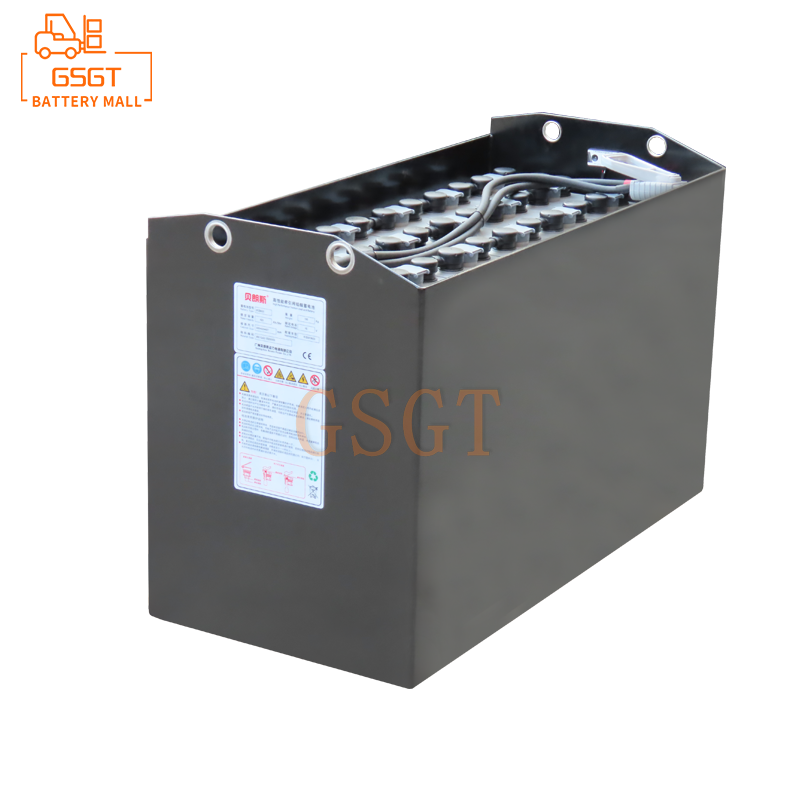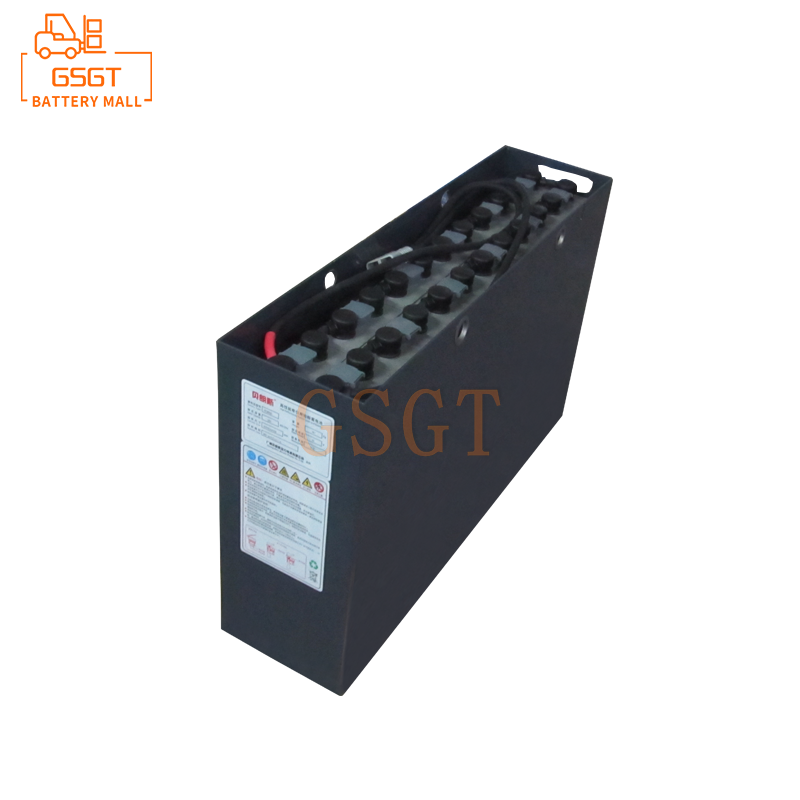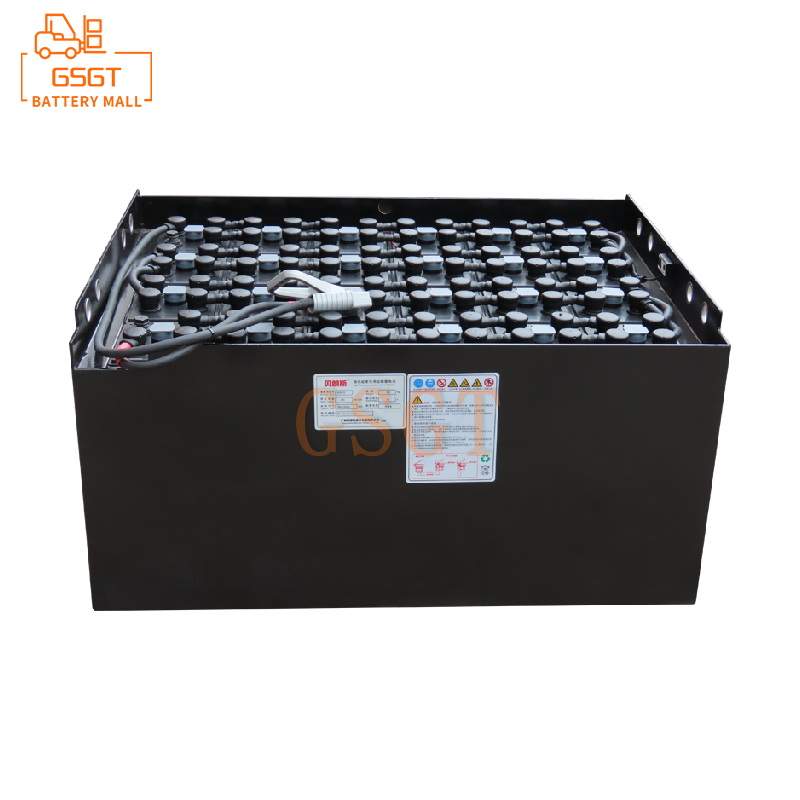Time:2025-05-09 10:39:08
Browse:603
Abstract
This article delves deeply into the sulfation of the plates in forklift lead-acid batteries, a common issue that affects battery performance. The causes of plate sulfation were analyzed in detail, covering multiple factors such as usage, maintenance and environment. Meanwhile, for different degrees of sulfation, effective repair methods are systematically expounded, and measures to prevent plate sulfation are introduced. The aim is to provide comprehensive and practical references for the rational use, maintenance and repair of forklift lead-acid batteries, so as to extend the battery service life and reduce the usage cost.
1. Introduction
Lead-acid batteries are widely used in the forklift industry, and their performance directly affects the working efficiency and operating costs of forklifts. However, plate sulfation is one of the more common and difficult problems in the use of forklift lead-acid batteries. Sulfation of the plates can lead to a decrease in battery capacity, a deterioration in charging and discharging performance, and in severe cases, even prevent the battery from working properly. Therefore, a thorough understanding of the causes of plate sulfation and the mastery of effective repair methods are of great significance for ensuring the normal operation of forklift lead-acid batteries and extending their service life.
2. Causes of Sulfation of Lead-acid Battery Plates in Forklifts
(1) Insufficient charging
1. Insufficient charging during daily use
Forklifts are frequently used in daily operations due to high work intensity. In many cases, in order to improve work efficiency, operators continue to use the battery before it is fully charged. During the charging process of lead-acid batteries, the lead sulfate on the plates needs to be fully converted into lead dioxide and spongy lead. If the charging is insufficient, the lead sulfate on the plates cannot be completely transformed and will gradually form coarse and insoluble lead sulfate crystals, eventually leading to sulfation of the plates.
2. Charging equipment failure or improper parameter Settings
If the charging equipment malfunctions, such as unstable charger voltage or abnormal charging current, it will affect the charging effect and fail to provide sufficient power to the battery. In addition, unreasonable Settings of charging parameters, such as too low charging voltage or too short charging time, will also prevent the battery from reaching a fully charged state, increasing the risk of sulfation of the plates.
(2) Over-discharge
1. Excessive use leads to deep discharge
In actual operation, forklifts sometimes continue to be used when the battery power is nearly exhausted due to urgent tasks or the operator's negligence, resulting in excessive battery discharge. When lead-acid batteries are over-discharged, the active substances on the plates will react violently with sulfuric acid, generating a large amount of lead sulfate. Excessive formation of lead sulfate will cause the lead sulfate crystals on the surface of the plates to grow rapidly, thereby triggering plate sulfation.
2. Failure to charge in time after discharging
When the forklift battery discharges, if it cannot be charged in time, the lead sulfate on the plates will gradually crystallize in the electrolyte. Especially when the battery is stored in a state of low charge for a long time, this crystallization process will intensify and eventually lead to irreversible sulfation.
(3) Issues related to electrolyte
1. The density of the electrolyte is too high
In pursuit of higher battery capacity and performance, some users will increase the density of the electrolyte. However, an excessively high electrolyte density will accelerate the corrosion of the active material on the plates and the formation of lead sulfate. Meanwhile, the high-density electrolyte will also raise the internal temperature of the battery, further promoting the formation and growth of lead sulfate crystals, leading to sulfation of the plates.
2. The electrolyte level is too low
During the operation of forklift lead-acid batteries, due to the evaporation of water and electrolysis, the liquid level of the electrolyte will gradually drop. If distilled water is not replenished in time, the part of the plate exposed above the liquid surface will come into contact with air and undergo an oxidation reaction, forming lead sulfate. Moreover, if the electrolyte level is too low, the local sulfuric acid concentration on the plates will be too high, accelerating the formation of lead sulfate crystals and causing sulfation of the plates.
3. The electrolyte is impure
If the electrolyte contains impurities such as iron, copper and other metal ions, these impurities will undergo electrochemical reactions inside the battery, affecting the normal charging and discharging process of the battery. The presence of impurities will change the electrochemical environment on the surface of the plates, promote the abnormal growth of lead sulfate crystals, and then lead to the sulfation of the plates.
(4) Environmental factors of use
1. The temperature is too high or too low
Excessively high ambient temperatures will accelerate the chemical reaction rate inside the battery, intensify the evaporation of the electrolyte, and at the same time speed up the aging of the active material on the plates and the formation of lead sulfate. In low-temperature environments, the chemical reaction rate of the battery slows down, the conductivity of the electrolyte decreases, and the charging and discharging efficiency of the battery drops. If the battery is over-discharged in a low-temperature environment, the lead sulfate on the plates is more likely to crystallize and is difficult to be completely transformed during the charging process, thereby causing sulfation of the plates.
2. Vibration and Jolting
During operation, forklifts are often in a state of vibration and jolting. This mechanical vibration will cause the active substances on the plates to gradually loosen and fall off, exposing the metal substrate of the plates. When the metal substrate comes into direct contact with the electrolyte, oxidation reactions are prone to occur, forming lead sulfate, which in turn leads to sulfation of the plates. Meanwhile, vibration may also loosen the connection points between the plates, affecting the electrical performance of the battery and further increasing the degree of sulfation of the plates.
(5) Battery Quality and Design Issues
1. The material and manufacturing process of the plates are poor
Some low-quality lead-acid batteries have impure lead alloy materials used for their plates, with a relatively high content of impurities. These impurities will affect the electrochemical performance of the plates, reduce the stability of the active substances, and make the plates more prone to sulfidation. In addition, imperfect manufacturing processes, such as uneven pressing density of the plates and unreasonable pasting processes, can lead to uneven local current distribution during the use of the plates, accelerate the formation of lead sulfate crystals, and cause sulfation of the plates.
2. The battery structure design is unreasonable
Some forklift lead-acid batteries may have structural design flaws. For instance, if the flow channels of the electrolyte are not smooth, it can lead to uneven electrolyte concentration inside the battery and excessive lead sulfate concentration in some areas, thereby causing sulfation of the plates. An unreasonable battery structure may also affect the heat dissipation effect, causing the battery to overheat during charging and discharging, and accelerating the sulfation process of the plates.
3. Repair Methods for Sulfation of Lead-acid Battery Plates in Forklifts
(1) Repair of mild vulcanization
1. Pulse Repair method
The pulse repair method utilizes high-frequency pulse current to repair the vulcanized plates. High-frequency pulse current can generate instantaneous high voltage and large current, breaking the lead sulfate crystals on the surface of the plates and redissolving them into the electrolyte. During the repair process, parameters such as the frequency, pulse width and amplitude of the pulse current need to be reasonably adjusted according to the specific conditions of the battery. Generally speaking, through continuous pulse repair for a period of time, the charging and discharging performance of the battery can be effectively improved and the battery capacity restored.
2. Shallow charge and shallow discharge cycle repair method
For batteries with mild sulfation, the shallow charge and shallow discharge cycle repair method can be adopted. That is, first charge the battery with a small current. When the battery voltage reaches a certain level, stop charging and discharge with a small current. By repeating this charge and discharge cycle multiple times, the active substances on the plates are gradually activated, and the lead sulfate crystals are gradually transformed into substances that can participate in the electrochemical reaction. This method is relatively simple to operate, but the repair process takes a long time and requires patience to repeat multiple cycles.
(2) Repair of moderate vulcanization
1. Chemical repair method
The chemical repair method is to repair the sulfation of the plates by adding specific chemical repair solutions to the battery. The chemical components in the repair solution can undergo a chemical reaction with lead sulfate, converting it into soluble substances. Commonly used components of repair solutions include organic acids, surfactants, etc. Before adding the repair solution, a portion of the electrolyte in the battery needs to be extracted first, and then the repair solution should be added in the prescribed proportion. After adding the repair solution, normal charging and discharging operations are carried out on the battery. Through the combined effect of chemical and electrochemical reactions, the sulfides on the plates are gradually eliminated.
2. High-pressure Repair method
The high-voltage repair method involves charging the battery with a voltage higher than the normal charging voltage. During the high-voltage charging process, a larger current can cause the lead sulfate crystals on the plates to gradually dissolve under the action of higher voltage and current, and reparticipate in the electrochemical reaction. However, it should be noted that the high-voltage repair method has high requirements for charging equipment and operation, and the charging time should not be too long; otherwise, it may cause other damages to the battery. Generally, when using the high-voltage repair method, it is necessary to closely monitor parameters such as the battery's voltage and temperature. Once the battery's performance has improved to a certain extent, it should be promptly switched to normal charging.
(3) Repair of Severe vulcanization
For batteries with severe sulfation, the repair is rather difficult and usually requires a combination of multiple methods for restoration. The chemical repair method can be adopted first. Add a strong repair solution and soak for a period of time to dissolve the sulfides on the plates as much as possible. Then, by combining the pulse repair method and the high-voltage repair method, through the action of different currents and voltages, the active substances of the plates are further activated to attempt to restore the battery performance. However, it should be made clear that even if a comprehensive repair method is adopted, severely sulfated batteries are still difficult to fully restore to their initial performance state, and the repair cost is relatively high. In some cases, if the repair cost is too high or the repair effect is not good, it may be necessary to consider replacing the battery.
4. Preventive Measures for Sulfation of Lead-Acid Battery Plates in Forklifts
(1) Use batteries reasonably
1. Avoid over-discharging and overcharging
During the operation of forklifts, it is necessary to strictly follow the battery capacity and the usage instructions to avoid excessive battery discharge. When the battery power drops to a certain extent, it should be charged in time. Generally, it is recommended to charge the battery when the remaining power is about 20% to 30%. At the same time, overcharging should also be prevented to avoid the battery remaining in an overcharged state for a long time, so as not to damage the battery plates.
2. Control the charging time and charging current
Set the charging time and current reasonably according to the specifications and capacity of the battery. During the normal charging process, the principle of constant current charging should be followed first, and then constant voltage charging should be switched to when the battery voltage reaches a certain value. Avoid using mismatched chargers or setting unreasonable charging parameters to ensure that the battery can be fully and reasonably charged.
(2) Regular maintenance and inspection
1. Check the electrolyte level
Regularly check the electrolyte level of the battery, usually at least once a week. When the electrolyte level drops below the specified mark, distilled water should be replenished in time to avoid adding other liquids containing impurities. When replenishing distilled water, be careful not to exceed the highest mark to prevent the electrolyte from overflowing.
2. Test the density of the electrolyte
Regularly use a densitometer to measure the density of the electrolyte. Adjust the density of the electrolyte reasonably based on the battery usage and seasonal changes. Generally, in summer, the density of the electrolyte can be appropriately reduced, and in winter, it can be appropriately increased. At the same time, it is necessary to ensure that the density of the electrolyte is uniform and avoid local density being too high or too low.
3. Clean the surface of the battery
Keep the battery surface clean and regularly remove dust, dirt and electrolyte residue from the battery surface. Impurities on the surface of the battery may cause self-discharge of the battery, affecting its performance. When cleaning, you can use a damp cloth to wipe. Avoid using organic solvents to prevent damage to the battery casing.
(3) Optimize the usage environment
1. Control the working environment temperature
Try to keep the working environment temperature of the forklift within an appropriate range. Generally, the optimal working temperature for lead-acid batteries is around 25℃. In high-temperature environments, appropriate cooling measures can be taken, such as installing heat dissipation devices around the battery; In low-temperature environments, batteries can be insulated or preheated before charging to enhance their charging and discharging performance and reduce the risk of sulfation on the plates.
2. Reduce vibration and jolting
During the operation of the forklift, try to avoid severe vibration and jolting. Choose a flat driving surface to reduce unnecessary sudden braking and sharp turns. At the same time, regular inspection and maintenance of the battery's fixing device should be carried out to ensure that the battery is firmly installed and to reduce the damage to the plates and sulfation problems caused by vibration.
(4) Select high-quality batteries and install them correctly
1. Choose reliable quality batteries
When purchasing lead-acid batteries for forklifts, it is necessary to choose products produced by regular manufacturers and of reliable quality. High-quality batteries offer more guarantees in terms of plate materials, manufacturing processes, and structural designs, which can reduce the probability of plate sulfation and extend the battery's service life.
2. Install the battery correctly
When installing the battery, make sure the installation position is correct and the connection is firm. The positive and negative terminals of the battery should be connected accurately to avoid reverse connection. At the same time, it is necessary to ensure that the connection lines between batteries have good contact to prevent local heating of the battery due to poor contact, which may affect battery performance and cause sulfation of the plates.
5. Conclusion
The sulfation of forklift lead-acid battery plates is a problem caused by the combined effect of multiple factors, and its causes involve multiple aspects such as charging, discharging, electrolyte, usage environment and the quality of the battery itself. For different degrees of plate sulfation, we can adopt corresponding repair methods, such as pulse repair method, chemical repair method, high-pressure repair method, etc. However, the repair of severely sulfated batteries is difficult and the effect is limited. More importantly, through preventive measures such as rational battery use, regular maintenance and inspection, optimization of the usage environment, selection of high-quality batteries and correct installation, the occurrence probability of plate sulfation can be effectively reduced, the service life of forklift lead-acid batteries can be prolonged, the working efficiency of forklifts can be improved, and operating costs can be lowered. In actual work, operators and maintenance personnel should pay full attention to the sulfation problem of lead-acid battery plates, combine prevention with repair, and ensure that the lead-acid batteries of forklifts are always in good working condition.

$2450

$1060

$5030

$5710

MESSAGE
Professional And Efficient
Security
Affordable Price
Professional Services